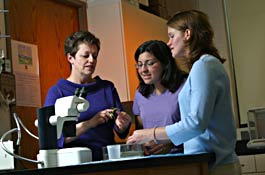“My students love fieldwork,” says Nancy M. Waters, associate professor of biology, whose field ecology program has extensive fieldwork. “Classes and research are complementary. Students learn research techniques in class and then do sampling in streams and lakes.” She regularly takes classes to nearby lakes and streams.
Waters specializes in aquatic plant ecology, particularly phytoremediation, the use of plants to improve water quality. While she continues to employ traditional ecological approaches, she has begun using molecular techniques to address some ecological issues. She is currently studying whether plants can survive mercury-contaminated waters by harnessing bacteria with the ability to convert mercury to a non-toxic form.
“There are some highly resistant plants and animals that can survive in a toxic environment, such as Onondaga Lake (a mercury polluted lake in upstate New York),” she says. “Exotic invaders such as Zebra mussels and broad leaf pond weed there have lower body burdens of mercury than the surrounding water, and we think it is because they harbor mercury resistant bacteria in their tissues.”
She says these invasive species are more broadly tolerant of less than ideal conditions, supplanting other plants that can’t acquire the ability to detoxify tissues quickly enough.
“The vegetation and bacteria exhibit a kind of mutualism. The bacteria gain access to rich resources within or on the plants, while the macrophytes eliminate a toxin from their tissues.”
Waters and her research students are trying to identify the bacterial species and strains with specific gene and accessory genes that allow these plants to detoxify mercury. They were hoping to find a water plant without the bacteria to see how quickly and under what conditions it may acquire the ability to convert mercury. From about three dozen samples provided by colleagues across the county, only those from a lake in Vermont lacked the mercury-resistant bacteria.
Small macroinvertebrates such as insect larvae, midges, snails, mollusks, and crayfish are also studied by Waters to track changes over time in a body of water.
“We want to know which species dominate, the habitat constraints, and seasonal impacts,” says Waters. “Community dynamics and interactions among the plants and invertebrates are important. A slight change in the environment can alter success and impact competition in aquatic systems.”
“What I like best about Lafayette is the interplay of courses and research and the potential to blend both,” she continues.
In addition to her biology courses, she teaches a VAST course on population and resource issues, Conception, Contraception and Carrying Capacity.
“I enjoy the opportunity to teach these types of courses, and learn new things each time I teach.”
One of the difficulties with her research is maintaining access to nearby water bodies over a long period to track changes over time.
“We lost access to a lake up in the Poconos when our contact moved,” she says. “Another fish pond we studied was wonderful but it had an earthen dam. When PFBS (Pennsylvania Fish and Boat Commission) sold the property to the local township, they ran afoul of DEP (Pennsylvania Department of Environmental Protection) concerns that the dam may pose a risk downstream, so the township deliberately breached the dam. Now the lake is a meadow.”
“Professor Waters is one of the teachers I remember most from my days at Lafayette,” says Thomas Gibbons ’87, project engineer, URS Corporation, New York City, and A.B. engineering graduate. “Even though I was not a biology major, Nancy allowed me to take Organism and Environment. I went on to take several more ecology courses with Nancy including an independent study where I examined the effects of liming acid lakes. I also assisted Nancy with a summer research project measuring fish nests, turbidity, and attracting leaches. In retrospect, it was her mentoring that allowed me to begin my career as an environmental consultant. I thank her for taking a chance on an engineering student and making my academic experience at Lafayette so positive.”
“Dr. Waters’ research students in my day called her Doc,” says Niki Hinson Learn ’97, an ecologist and biology graduate who studied salt marshes at Rutgers University, earning an M.S. in ecology and evolution. “Doc was always friendly and generous with her time. She gave lectures that were both informative and amusing and treated the students with respect. She was both mentor and friend to her research students. I went to college knowing that I was interested in ecology, having always been a conservationist by nature. Prior to attending Lafayette, I lived in the Sonoran Desert in Tucson, Ariz. I hadn’t really thought much about working in aquatic systems, but I enjoyed working in lakes and streams with Doc. She influenced the direction of my career in ecology.”
Highlights
Publications: “Renewable Energy: Policy, Public/Private Partnerships and Promise,” pp. 460-471 in S.K. Majumdar , E.W. Miller and A.I. Panah (eds.). Renewable Energy: Trends and Prospects; Pennsylvania Academy of Science, Easton, Pa., 2002; Waters and Christopher R. SanGiovanni ’95, “Distribution and Diversity of Benthic Macroinvertebrates Associated with Aquatic Macrophytes,” Journal of Freshwater Ecology 17(2), pp. 223-232, 2002.
Honors: Student Government Superior Teaching Awards, 1988, 1992, 1993.
Achievements: Organization Committee of the Faculty 1991-92; Board of Trustees Committee on External Affairs 1995-97; Institutional Review Board 1995-98 (chair 1996-97); Faculty Curriculum Committee 1995-98 (chair 1997-98); Faculty Compensation Committee, 2000 to present (chair 2001-02 and 2002-03).
Contact: (610) 330-5467, watersn@lafayette.edu

Nancy Waters, associate professor of biology (left), Maureen Auro ’03 (center), and Christine Williams ’03 examine a specimen of the aquatic plant Vallisneria americana.
